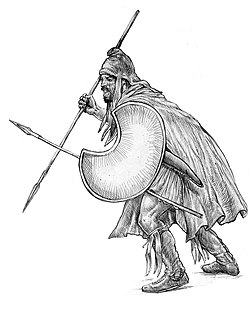Warrior: Difference between revisions
made Athena a link |
|||
| Line 135: | Line 135: | ||
*[[Mandalorians]] |
*[[Mandalorians]] |
||
*[[Montenegrins]] |
*[[Montenegrins]] |
||
Adam Wenger |
|||
*[[Ninja]] |
*[[Ninja]] |
||
*[[Phalangite]] |
*[[Phalangite]] |
||
Revision as of 16:20, 2 April 2008


This article needs additional citations for verification. (March 2008) |
According to the Random House Dictionary, the term warrior has two meanings. The first literal use refers to "a person engaged or experienced in warfare." The second figurative use refers to "a person who shows or has shown great vigor, courage, or aggressiveness, as in politics or athletics." [1]
Overview
In tribal societies engaging in endemic warfare, warriors often form a caste or class of their own. In feudalism, the vassals essentially form a military or warrior class, even if in actual warfare, peasants may be called to fight as well. In some societies, warfare may be so central that the entire people (or, more often large parts of the male population) may be considered warriors, for example in the Iron Age Germanic tribes or the Medieval Rajputs.
Professional warriors are people who are paid money for engaging in military campaigns and fall into one of two categories: Soldiers, when fighting on behalf of their own state; or mercenaries, when offering their services commercially and unrelated to their own nationality. The classification of somebody who is involved in acts of violence may be a matter of perspective, and there may be disagreement whether a given person is a hooligan, gangster, terrorist, rebel, freedom fighter, mercenary or a soldier.
Warrior classes
Some societies have had a privileged social class or caste with special responsibility for warfare. This class could be hereditary or qualified. See also nobility.
In 1937 Georges Dumézil famously speculated that Proto-Indo-European society was composed of a priestly class, a warrior class, and an agrarian class. The Indian society was based on these lines, composing of the Brahmins (priests), the Kshatriya (warriors), the Vaishya (business class) and the Shudras (servants). In contemporary Jungian psychology, the warrior is often seen as a key archetype of masculinity.
Warrior code
In many societies in which a specialized warrior class exists, specific codes of conduct (ethical codes) are instituted in order to ensure that the warrior class is not dangerous to the rest of society. Warrior codes often have common features and usually value honour in the forms of faith, loyalty and courage. Examples include the medieval knights' code of chivalry, the Kshatriya code of Dharma in India and Japanese samurai Bushido. See also noblesse oblige.
Warrior cultures
A warrior culture is a civilization that heavily emphasizes battle and war and greatly prizes feats of arms. Warrior cultures often incorporate a cult of personality around military leaders.
Examples of societies in history that could be designated as warrior cultures include:
- Apache
- Ancient Macedonians
- Afghan or Pashtoon
- Anglo-saxons
- Arumer Black Heap under Pier Gerlofs Donia, Frisia
- Aztecs
- Barbadian
- Caribs
- Celts
- Christian Knights
- Chekavar from Kerala, India
- Cheyenne Dog Soldiers
- Cossack
- Crimean Tatars
- Dani people
- Franks
- Germanic Peoples
- Haida
- [(Holmes Hall - Raashid Khan and Zack Simons)]
- Jurchen
- Kshatriyas from India
- Maori
- Maratha clan system
- Masai
- Matabele
- Mongols under Genghis Khan
- Perbun
- Rajput
- Romans
- Scythians
- Sambal people of the Philippines
- Samurai
- Sparta
- Tuareg
- Turks
- Velama
- Vikings
- Yanomami
- The Zulu under Shaka
Feudal societies are not always warrior cultures, since although feats of arms are prized, there is not necessarily an emphasis on battle and war. In some feudal societies, the soldiery was provided through conscription of the peasant class.
Women as warriors
In Ancient Egypt, the earliest of recorded histories of human culture, Ahhotep I and Hatshepsut are documented as warrior queens. Others in various early cultures are documented as well.
In Nubia, the warrior queen, Candace of Meroë put up such a show of force in 332 BC that Alexander the Great withdrew from his attempt to enter her country and diverted his invasion to Egypt instead. Later, another warrior queen of Nubia, led her forces against an attempted invasion by Augustus of Rome and her archers defeated them also.
Since Eurypyle, Deborah, and Vishpala there have been references to women warriors throughout history. Boudica lead an enormous army that is well documented. See the list provided above for many more. Yet until modern times, however, warrior women mostly have been noted by historians as an exception or a curiosity. One example of a group of fighting women is the legend of the Amazons, that is recorded in myths.
Today, women are recruited to serve in the military in most countries, while only a few countries permit women to fill active combat roles, including Sweden, Canada, Denmark, Finland, Germany, Norway, and Switzerland.
Notes
References
- Shannon E. French, Code of the Warrior - Exploring Warrior Values Past and Present (2003).
See also
William Stanley
